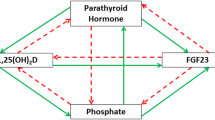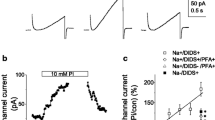Summary
The characteristics of the transport of inorganic phosphate (Pi) in osteoblastic cells have been determined using the osteosarcoma cell line ROS 17/2.8. The initial rate of the Pi transfer from the extracellular into the intracellular osteoblastic compartment is mediated by a sodium-dependent process. The stoichiometric analysis of the cotransport system suggests that two sodium ions would be transferred with each Pi molecule. In the presence of sodium, the Pi transfer was saturable with increasing extracellular Pi concentration. In the absence of extracellular sodium, only a negligible amount of Pi enters the osteoblastic cells, with a kinetic compatible with a simple diffusion process. The kinetic parameters of the saturable component of the Pi transport measured at an external sodium concentration of 143 mmol/liter were Km=448±12 μmol/liter; Vmax=37.1±0.7 nmol/mg prot. 4 min. In the presence of 0.1 mmol/liter Pi, the half-maximal activation by sodium was obtained at 43±1.3 mmol/liter. The Pi transport rate was reduced by arsenate, by metabolic inhibitors such as FCCP and by ouabain, an inhibitor of Na−K ATPase. These results strongly suggest that the Pi transfer into osteoblastic cells is a carrier-mediated process which is driven by the transmembrane electrochemical gradient of sodium.
Similar content being viewed by others
References
Kahn AJ, Fallon MD, Teitelbaum SL (1984) Structure-function relationships in bone: an examination of events at cellular level. In: Peck WA (ed) Bone and mineral research annual 2. Elsevier Science Publishers, p 125
Bingham PJ, Raisz LG (1984) Bone growth in organ culture: effects of phosphate and other nutrients on bone and cartilage. Calcif Tissue Res 14:31–48
Parfitt AM, Mathews C, Rao D, Frame B, Kleerekoper M, Villanuery AR (1981) Impaired osteoblast function in metabolic bone disease. In: Frame B, Potts JT (eds) Clinical disorders of bone and mineral metabolism. J Excerpta Medica, Amsterdam, pp 116–119
Harrison HE, Harrison HC (1979) Calcium and phosphate homeostasis. In: Harrison HE, Harrison HC (eds) Disorders of calcium and phosphate metabolism in childhood and adolescence. WB Saunders Co, Philadelphia, London, Toronto, pp 15–46
Marel GM, McKenna MJ, Frame B (1986) Osteomalacia. In: Peck WA (ed) Bone and mineral research. Elsevier Science Publishers BV, pp 335–412
Glorieux FH, Marie PJ, Pettifor JM, Delvin EE (1980) Bone response to phosphate salts, ergocalciferol, and calcitriol in hypophosphatemic vitamin D-resistant rickets. N Engl J Med 303:1023–1031
de Vernejoul MC, Marie P, Kuntz D, Gueris J, Miravet L, Rychkewaert A (1983) Nonosteomalacic osteopathy associated with chronic hypophosphatemia. Calcif Tissue Int 34:219–223
Marie PJ, Glorieux FH (1983) Relation between hypomineralyzed periosteocytic lesions and bone mineralization in vitamin D-resistant rickets. Calcif Tissue Int 35:443–448
Harrison HE, Findberg L (1981) Rickets: primary hypophosphatemic and vitamin D-dependent varieties. J Pediatr 99:84–86
Lyles KW, Harrolson JM, Drezner MK (1982) The efficacy of vitamin D2 and oral phosphorus therapy in X-linked hypophosphatemic rickets and osteomalacia. J Clin Endocrinol Metab 54:307–315
Drezner MK, Lyles KW, Haussler MR, Harrelson JM (1980) Evaluation of a role for 1,25-dihydroxyvitamin D3 in the pathogenesis and treatment of X-linked hypophosphatemic rickets and osteomalacia. J Clin Invest 66:1020–1032
Rasmussen H, Mazur A, Pechet M, Gertner J, Baron R, Anast C (1982) Treatment of familial hypophosphatemic rickets. In: Norman AW, Schaefer K, Herrath PV, Grigoleit HG, de Gruyter W (eds) Vitamin D: chemical, biochemical and clinical endocrinology of calcium metabolism. Walter de Gruyter, Berlin, New York, pp 1219–1225
Majeska RJ, Rodan SB, Rodan GA (1980) Parathyroid hormone-response clonal cell lines from rat osteosarcoma. Endocrinology 107:1494–1503
Rodan GA, Rodan SB (1984) Expression of the osteoblastic phenotype. In: Peck WA (ed) Bone and mineral research annual 2. Elsevier Science Publishers BV, pp 244–285
Dulley JT, Grieve PA (1975) A simple technique for eliminating interference by detergents in the Lowry method of protein determination. Anal Biochem 64:136–141
Lowry DH, Rosebrough NJ, Farr AL, Randall RJ (1951) Protein measurement with the Folin phenol reagent. J Biol Chem 265–275
Hoffmann N, Thees M, Kinne R (1976) Phosphate transport by isolated renal brush border vesicles. Pflügers Arch 362:147–196
Biber J, Brown CDA, Murer H (1983) Sodium-dependent transport of phosphate in LLC-PK1 cells. Biochim Biophys Acta 735:325–330
Danisi G, Murer H, Straub RW (1984) Effect of pH on phosphate transport into intestinal brush border membrane vesicles. Am J Physiol 246:G180-G186
Caverzasio J, Danisi G, Straub RW, Murer H, Bonjour JP (1987) Adaptation of phosphate transport to low phosphate diet in renal and intestinal brush border membrane vesicles: influence of sodium and pH. Plügers Arch 409:333–336
Brunette MG, Belireau R, Chan M (1984) Effect of temperature and pH on phosphate transport through brush border membrane vesicles in rats. Can J Physiol Pharmacol 62:229–234
Burckhardt G, Stern H, Murer H (1981) The influence of pH on phosphate transport into rat renal brush border membrane vesicles. Pflügers Arch 390:191–197
Author information
Authors and Affiliations
Rights and permissions
About this article
Cite this article
Caverzasio, J., Selz, T. & Bonjour, J.P. Characteristics of phosphate transport in osteoblastlike cells. Calcif Tissue Int 43, 83–87 (1988). https://doi.org/10.1007/BF02555151
Received:
Revised:
Issue Date:
DOI: https://doi.org/10.1007/BF02555151




